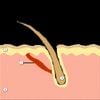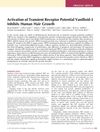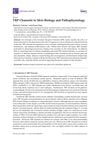Cryo-EM and Molecular Dynamics of TRPV3 Channel in Activated State Reveal Structural Features Implicated in Severe Itch and Hyperkeratosis
TRPV3 channel keratinocytes epidermal barrier formation hair follicle growth keratinocyte-mediated inflammation cutaneous itch pain sensation gain of function mutations Olmsted syndrome keratinocyte hyperproliferation cryo-EM heat-activated state wild type resting state S6 domain TRP box domain W692G mutation hyperkeratosis molecular dynamic simulation skin barrier hair growth skin inflammation itch pain mutation skin cell overgrowth cryogenic electron microscopy heat activation resting state S6 segment TRP box W692G thickened skin molecular dynamics

TLDR The TRPV3 channel structure changes linked to severe itch and hyperkeratosis were identified using cryo-EM.
The TRPV3 channel, a non-selective cation channel highly expressed in keratinocytes, plays a significant role in skin physiology, including epidermal barrier formation, hair follicle growth, and keratinocyte-mediated inflammation. It also mediates cutaneous itch and pain sensation. Gain of function mutations in this channel have been linked to severe skin diseases like Olmsted syndrome, which is characterized by severe itch and keratinocyte hyperproliferation. The study used cryogenic electron microscopy (cryo-EM) to examine the structure of TRPV3 in both its heat-activated and wild type resting states. The structures of the two states were remarkably similar, but a structural difference was found in the segment linking the S6 and TRP box domains, which contains the W692G gain-of-function mutation found in Olmsted syndrome. This suggests that this structural feature could be mechanistically related to severe itch and hyperkeratosis. Molecular dynamic simulation showed greater random molecular movement in the activated channel, indicating that the structural feature may predispose the channel to greater structural instability.



